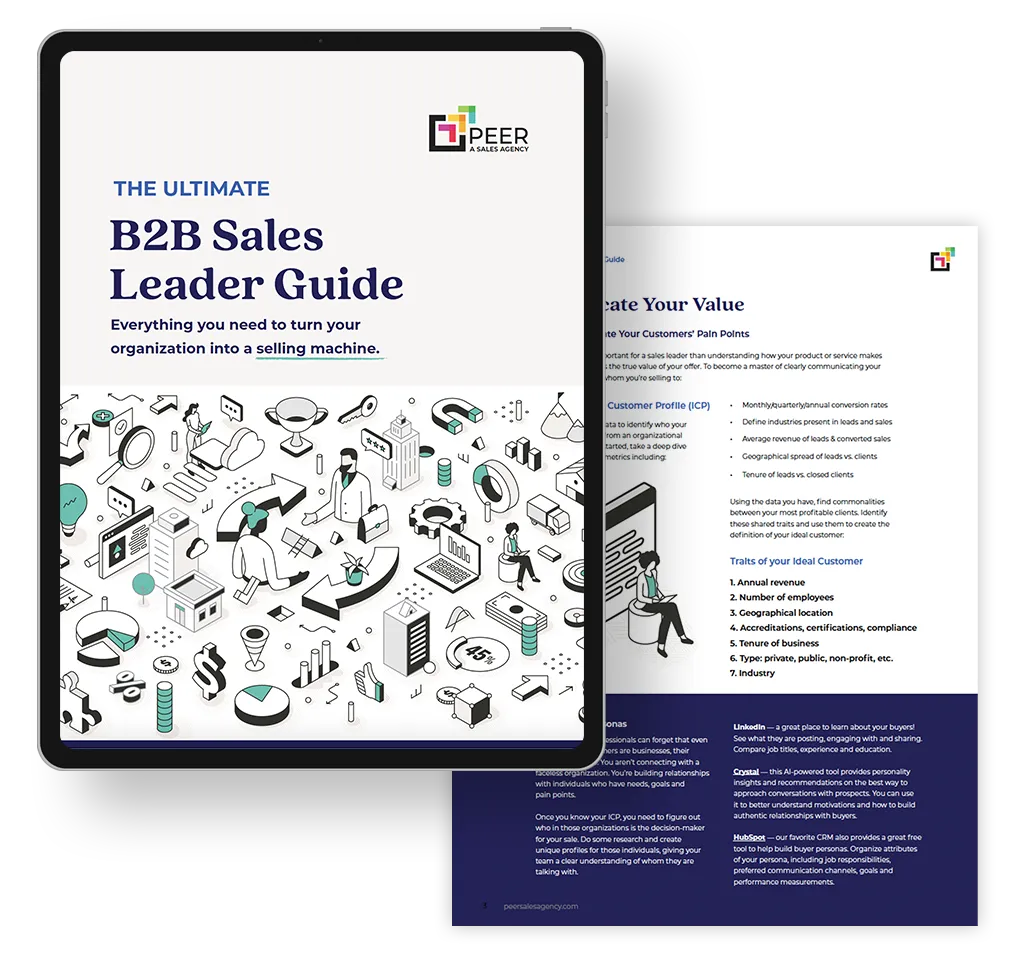Whether this is your 5th or 50th year in business, you understand the importance of establishing a solid company budget. But are you thinking about your marketing budget in the right way?
It’s crucial to allocate resources effectively to ensure your marketing efforts are successful and impactful. You’ve got to factor in your overall business goals, target audience, competitors, and available resources to determine what your B2B marketing budget should be.
Without a budget, it’s easy to overspend or miss out on important opportunities. A budget also shows your stakeholders that you’re responsible and strategic in your approach to marketing. Essentially, your marketing budget should help your team stay focused, organized, and accountable as you work towards your overall business goals.
By strategically planning and allocating your budget, you can maximize your marketing efforts, support your sales team, and scale your business.
Set Your Budget as a Percentage of Revenue
Here’s the deal: your marketing budget is the amount of money set aside for all the marketing activities. Once it’s set for the year, it’s unlikely you’re going to get more. To figure out the right budget for your company’s size and goals, it’s best to start with a percentage of your company’s revenue.
The percentage you use for your specific company depends on a few things, like industry, company size, and business goals. But a common range is around 5-12% of your annual revenue.
Here’s a simple formula to get you started: take the projected revenue for the year and multiply it by the percentage you’ve chosen. That gives you your marketing budget.
But hold up – before you go wild with that budget, remember to consider any special projects, new product launches, or market expansions that might need extra funds. Here are a few example percentages, gathered from the experts:
1. Deloitte’s CMO Survey: 9.2% of revenue goes to marketing
Deloitte supports The CMO Survey—conducted biannually since 2008 by Duke University’s Fuqua School of Business marketing professor Christine Moorman—as a measure of how marketing leaders are navigating this brave new world. The survey reports on their priorities and plans enabling marketers to compare staffing, budgeting, and investment areas, and identify potential trends.
Marketing comprised roughly 13.6% of the average company’s total budget in 2023, according to the survey. (blog.hubspot.com) That’s up 3.9% from years prior on this survey, which could mean there’s more competition in the market than ever before, especially for B2B companies.
The CMO Survey further found that on average, companies invest 9.2% of their revenue into marketing.
2. Gartner Survey Says: 9.1% of revenue invested in marketing
Gartner surveys 400-500 C-Suite Marketers each year for their State of Marketing Budget and Strategy report.
According to Gartner, the average marketing budget sits at 9.1% of revenue into marketing efforts. In a bit of contrast from the CMO Survey, this report is actually down from the pandemic-era high 9.5% of revenue.
According to the Gartner report, smart planning and agility are key to CMO success. This means doubling down on planning, analysis, and flexibility. It’s also critical to find proven strategies and partners that can help streamline your marketing efforts and maximize your budget.
3. SaaS Capital: Try 10%
SaaS Capital® is a provider of long-term Credit Facilities to SaaS companies. In their 12th annual survey, completed in March 2023, the firm saw more than 1,500 SaaS companies respond.
The SaaS Capital budgeting model recommends investing a full 10% of your revenue into marketing efforts. This is unchanged from the 2022 survey, which means that SaaS budgets have remained relatively steady. This higher-than-average spend also means that SaaS companies may face stiff competition in digital advertising, with the largest companies spending millions on tactics like search and social ads.
What Gets Included in Your Marketing Budget?
Your entire marketing budget must account for much more than just digital advertising. Your budget should include every activity and cost associated with the promotion and reach of your business, from software licenses to staff salaries.
Here are the common items that should be allocated for in a marketing budget:
- CRM software
- Staff salaries and benefits
- Paid digital advertising
- Conferences and trade shows
- Sales enablement assets
- Marketing materials and collateral
- Public relations and media outreach
- Website maintenance and development
- Marketing research and analytics
- Agency and consultant fees
- Promotional events and sponsorships
- Miscellaneous expenses
This list is by no means all-inclusive. Consider the specific needs of your business: signage on your building, wraps for your vehicles, airfare to conferences, and much more can figure into your overall budget. Each of these items can play a crucial role in achieving marketing objectives.
Top Marketing Tactics by Industry
When creating a marketing budget, it’s important to consider the specific needs and goals of your industry. Here are some examples of the kind of B2B marketing tactics that make the biggest impact by industry:
SaaS & Technology:
- Trade shows and conferences
- Digital advertising
- Content marketing
- Relationship-based sales enablement
Financial services:
- Email marketing
- Social media advertising
- Webinars and thought leadership content
- Content marketing
Healthcare:
- Direct mail campaigns
- Search engine optimization
- Content marketing
- Email marketing
- Event sponsorships
Construction/Manufacturing:
- Industry trade publications
- Account-based marketing
- Customer success programs
- Relationship-based sales enablement
Professional services:
- Search engine marketing
- Networking events
- Case studies and testimonials
- Content marketing
- Relationship-based sales enablement
Every industry has a unique, secret recipe for marketing success. By tapping into the needs and goals of the buyers in your industry, you can craft a budget that maximizes your potential without wasting dollars on channels that just don’t make sense.
7 Tips to Create a B2B Marketing Budget That Gets Results
Setting a marketing budget that aligns with your business goals is crucial for success. As with most budget decisions, not everyone can get everything they want. It’s up to leadership to prioritize where and how to allocate your resources to achieve the best results… and that’s a heavy burden.
Here are seven tips to make that burden just a little lighter as you set your B2B marketing budget:
1. Do Your Research
This should not be a guessing game. When creating a marketing budget, it’s important to start by researching your industry. Look for common marketing budgets for companies similar to yours – the surveys and reports linked earlier in this article are a great place to start.
You should also talk to other industry professionals, either by connecting on professional networks like LinkedIn or attending industry events and conferences.
Understanding the typical marketing investments in your industry will provide a solid foundation for creating your budget. Then, you can tailor it to fit your specific needs and goals. Research helps you avoid overspending on channels that don’t work, or under-spending on highly competitive channels.
2. Be S.M.A.R.T.
Setting clear goals is crucial when creating a marketing budget. We still recommend using the tried and true SMART method to ensure goals are specific, measurable, achievable, relevant, and time-bound.
This means clearly defining what you want to achieve, such as increasing sales by a certain percentage or reaching a specific target market. It’s important to have measurable metrics in place to track progress, such as website traffic or customer engagement.
Make sure the goals are achievable within the constraints of the budget and resources available. They should also be relevant to the overall marketing strategy and the needs of the business. Finally, set a realistic timeline for achieving these goals.
By using the SMART method, you can ensure that the marketing budget is aligned with the specific objectives of the business and that resources are allocated in a way that maximizes the return on investment. This approach also allows for clear and transparent communication with stakeholders about the expected outcomes and how success will be measured.
3. Bust Out the Spreadsheets & Calculators
When creating a marketing budget, it’s important to consider all recurring and all potential costs. Start by looking back at previous years to get an idea of what you’ve spent on marketing tactics. Determine which tactics and costs you’ll carry forward to the new budget. Then, add in any new tactics or tests you want to try in the coming year. This can include things like partnerships, advertising, social media marketing, events, promotions, and more.
Don’t forget to factor in the cost of any new tools or software you might need to implement these tactics.
By considering all potential costs, you can ensure that your marketing budget is comprehensive and allows for the successful execution of your marketing strategies.
4. Don’t “Set it and Forget it.”
It’s crucial to keep track of costs over time. Whether you use a spreadsheet or software program, regularly review and compare your marketing budget to actual spend.
If you notice that certain strategies aren’t producing the desired results, it’s time to make adjustments. Consider reallocating funds to more effective channels or tactics. Additionally, if there are unexpected changes in the market or within your company, be prepared to revise your budget accordingly.
This proactive approach will help you make the most of your resources and drive better results for your business.
5. Use Hired Guns to Fill the Gaps
Whether you need specialized skills, more capacity to quickly produce the content and sales enablement assets you need or you need additional strategic support, hiring a results-driven marketing agency is a smart move for most mid-sized businesses.
The right marketing agency can provide expertise in areas your internal team lacks, like paid digital marketing campaigns, social media, website development, content creation, sales enablement, marketing strategy support, and a lot more.
By partnering with a marketing agency, your business can tap into specialist knowledge and resources to enhance your marketing efforts and drive better results – without paying the high salaries associated with in-house graphic designers, web developers, and writers. You can also avoid trying to find a decent freelancer at the drop of a hat. It’s a strategic investment that can help you maximize your impact and achieve your business objectives.
6. Content is Key to Capturing Your Audience
Billions of people use the internet to search for solutions to their problems. They’re reading about those solutions on websites, blogs, and social feeds. Your buyers are out there! Content marketing, also called Inbound Marketing, is the way your brand connects your solution with your audience.
Content builds trust and credibility, and can ultimately drive sales. It also supports the sales team by giving them ready-made email deposits and objection-busters to help smooth the sales process.
By creating valuable and relevant content, you can establish your brand as an industry leader and attract new customers. Content marketing is also key to search engine optimization, making it even easier for potential customers to find your business online.
Overall, investing in content marketing is a smart move for any company looking to grow its customer base, build brand awareness, and support its sales team. It’s a long-term strategy that can deliver lasting results.
Content repurposing and updating
Part of that investment is in creating evergreen, reusable content. Repurposing content allows your business to reach new audiences and maximize the value of our existing content.
By transforming blog posts into infographics or videos, you can engage with different types of prospects on new channels and increase your brand visibility.
In addition to repurposing your content, updating and adding to your existing content ensures that it remains relevant and up-to-date, providing value to your audience and improving your search engine rankings. This also conserves some of your marketing spend, by optimizing the content you’ve already paid to create.
Both are cost-effective ways to maintain a consistent online presence and demonstrate your industry expertise, and both strategies are essential for staying competitive in today’s digital landscape.
7. Be Ready (and willing!) to Listen and Pivot
You need to regularly audit and re-evaluate your marketing strategy. This means checking in on your campaigns and initiatives to see what’s working and what’s not. It also means checking in with your sales team to make sure they’re getting what they need from the marketing side.
By measuring the results of your marketing efforts, your business can make informed decisions about where to allocate your budget for the best return on investment.
One way to measure results in marketing is to use key performance indicators (KPIs) such as website traffic, lead generation, conversion rates, and customer acquisition cost. By tracking these metrics, you’ll see which channels and tactics are driving the most value for your business.
You also want to be tuned in to your sales and marketing alignment. Often referred to as “smarketing,” this is the practice of unifying your sales and marketing teams around a shared system of communication, methodology, and business goals so they can function as two halves of the same whole. Make sure your sales team is supported, happy, and closing deals.
Last but not least, it’s important to stay up to date with industry trends and changes in consumer behavior. Don’t stay married to a channel or tactic that your prospects have abandoned! Allow your business, and your marketing tactics, to meet the evolving needs of your target audience.
By staying agile and open to change, you ensure that your marketing budget is being used effectively.
Get a Marketing Strategy That Works
Creating a marketing strategy that works within your budget and gets results for your business shouldn’t be a one-person show. It takes a deep bench of experts to produce content marketing and sales enablement assets that convert website visitors into leads, and leads into sales, more effectively.
You don’t have to go it alone, and there’s no need to create your marketing strategy from scratch. Get our proven strategy for driving revenue using digital tools. Download our quick guide to:
- Structure your sales funnel based on a phased timeline
- Align marketing tactics and key sales enablement with each phase
- Identify key performance indicators to help track success
- Find out how your sales and marketing teams can work together in each stage of the funnel to move prospects along
Get the most from your marketing dollars. Download the Revenue Generation Playbook today!



